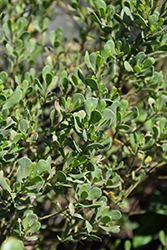It's all about ...
plants

Height: 6 feet
Spread: 7 feet
Sunlight:
![]()
Hardiness Zone: 8b
Other Names: Hammock Groundsel
Description:
This medium sized shrub produces clusters of fragrant white and yellow flowers in late summer that are very attractive to pollinators; nicely rounded habit and dense foliage makes a great screen; tolerant of heat, cold, and salt exposure
Ornamental Features
Broombush Falsewillow is bathed in stunning clusters of fragrant white flowers with yellow overtones at the ends of the branches from late summer to early fall. It has attractive grayish green evergreen foliage which emerges light green in spring. The fragrant oval leaves are highly ornamental and remain grayish green throughout the winter.
Landscape Attributes
Broombush Falsewillow is a dense multi-stemmed evergreen shrub with a more or less rounded form. Its average texture blends into the landscape, but can be balanced by one or two finer or coarser trees or shrubs for an effective composition.
This is a relatively low maintenance shrub, and should only be pruned after flowering to avoid removing any of the current season's flowers. It is a good choice for attracting bees and butterflies to your yard, but is not particularly attractive to deer who tend to leave it alone in favor of tastier treats. It has no significant negative characteristics.
Broombush Falsewillow is recommended for the following landscape applications;
- Hedges/Screening
- Rock/Alpine Gardens
- General Garden Use
- Naturalizing And Woodland Gardens
Planting & Growing
Broombush Falsewillow will grow to be about 6 feet tall at maturity, with a spread of 7 feet. It has a low canopy, and is suitable for planting under power lines. It grows at a medium rate, and under ideal conditions can be expected to live for approximately 20 years.
This shrub should only be grown in full sunlight. It is quite adaptable, prefering to grow in average to wet conditions, and will even tolerate some standing water. This plant should not require much in the way of fertilizing once established, although it may appreciate a shot of general-purpose fertilizer from time to time early in the growing season. It is not particular as to soil type or pH, and is able to handle environmental salt. It is somewhat tolerant of urban pollution. This species is native to parts of North America.
This plant is not reliably hardy in our region, and certain restrictions may apply; contact the store for more information.
